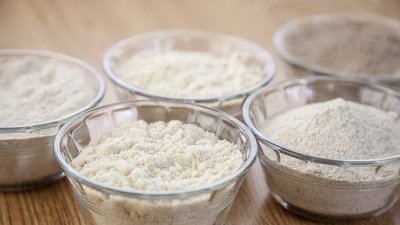All sorts of grains, nuts, and legumes can be ground up into flours that offer unique tastes and impressive nutritional resumes. I've sifted through the contenders and put together a list of the flours that will guarantee your next stack of waffles or cookies rise above the rest. Find them at health-food or bulk stores, selected larger supermarkets, or online outlets such as Bob's Red Mill.
To keep them fresh, store small amounts of the flours you're going to use within the month in a container stored in a cool, dark location. Store the remainder in your fridge—or better yet, the freezer. Use an airtight container to extend shelf life. Bring flours back up to room temperature before cooking with them.
1. Spelt Flour
Spelt is a very old, hardy variety of modern-day wheat that is especially popular in Germany. When whole spelt berries are milled, you end up with spelt flour, which has a slightly sweet flavor without any of the earthy bitterness associated with traditional whole-wheat flour. Spelt provides an array of essential vitamins and minerals, including magnesium, phosphorus, niacin, manganese, and copper. Its natural sweetness means you might be able to hold back a bit of the sugar called for in a given recipe.
Be aware that like whole-wheat flour, spelt flour is available in both less- and more-refined (often labeled "light" or "white") forms, with whole-spelt flour being the most nutritionally dense option. You may even come across spelt flour ground from sprouted grains, which may provide added nutritional benefits.
In the kitchen: Baking with spelt flour is great because it won't make cakes or breads heavy and dense—a common complaint directed at whole-grain flours. Instead, you end up with products that are soft, tender, and delicious.
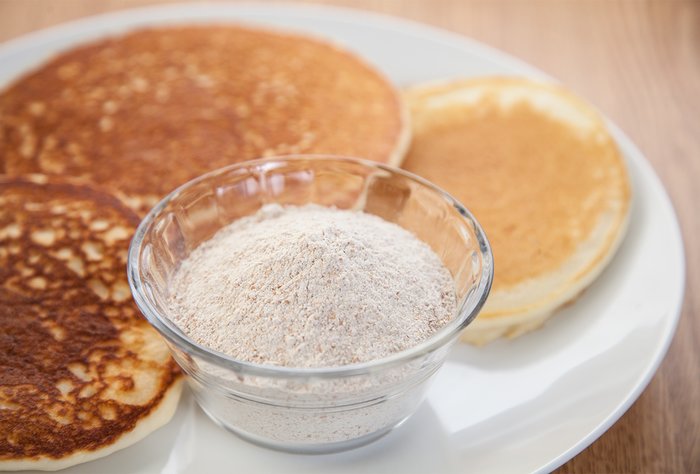
Whenever a recipe such as pancakes, muffins, brownies, pizza crust, scones, or cookies calls for all-purpose or whole-wheat flour, there's a good chance that a 1-to-1 substitution with spelt flour will work out great. Just one caveat: Spelt flour tends to absorb a bit less liquid than regular flour, so hold back about 10 percent of any liquid like milk in the beginning; you can always add more later. That means if a recipe calls for 1 cup of liquid (8 ounces), try starting with 7 ounces.
2. Teff Flour
Indigenous to Northeast Africa, malty sweet-tasting teff flour is produced by milling one of the world's tiniest grains, harvested from an ancient grasslike plant. Teff's bran and germ are the most nutrient-dense parts of a whole grain and make up a large percentage of the total. Start using teff flour, and you'll benefit from an extra dose of fiber, B vitamins, calcium, and iron. It's also gluten-free and higher in protein than standard whole-wheat flour.
In the kitchen: Traditionally, teff has been associated most often with injera, a spongy fermented flatbread served at Ethiopian restaurants. However, it pairs wonderfully with a range of breakfast favorites and baked goods, including waffles, pancakes, pizza crusts, muffins, cakes, cookies, brownies, and tart crusts. It's particularly great in any recipe using cocoa powder.
Start by substituting teff flour for about 25 percent of the regular flour called for in a recipe and then experimenting from there. However, you cannot replace all of a gluten-containing flour such as whole-wheat or spelt in a recipe with a non-gluten one like teff or almond and expect good results. Gluten contributes many important properties to baked goods, such as structure and rising.
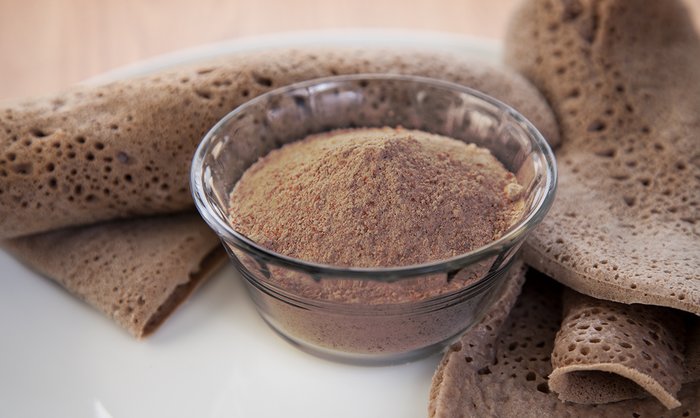
3. Almond Flour
Made by pulverizing whole almonds, this slightly sweet and nutty flour has a nutritional resume that puts wheat flour to shame. Most notably, there are higher levels of heart-healthy monounsaturated fats, bone-strengthening calcium, and the potent antioxidant vitamin E. And for the carb-conscious, replacing some of the regular flour in a recipe with almond flour helps you cut back.
There are two versions of almond flour available on the market: one made by finely grinding skinless blanched almonds and another produced when almonds with their skins still intact are pulverized. The former produces a finer texture that some believe brings about better results when used in baking. The latter, which is often called "almond meal" or "natural," brings about a courser ground flour for denser, more rustic results. The advantage of using unskinned almond flour is that you may benefit from the increased nutrition supplied by the skins.
In the kitchen: This nutty flour is highly versatile. You can use it in place of 25 percent of the flour in most recipes, stir it into your oats or morning yogurt, replace the breadcrumbs in meatloaf, or use it as a coating for chicken and fish.
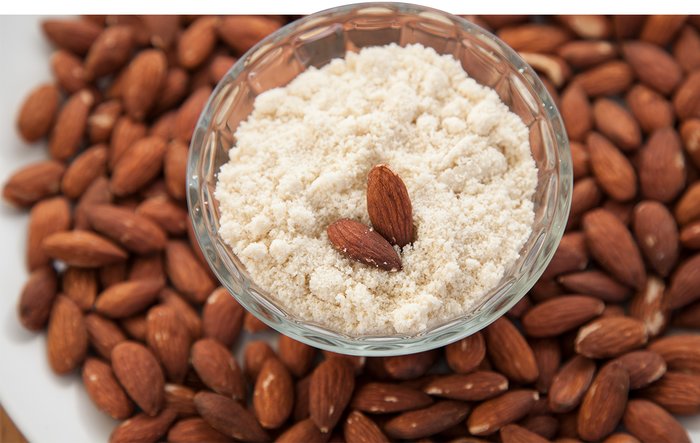
Keep in mind that nut flours like almond can burn more easily than grain-based versions. So you may want to try using a lower cooking temperature and a longer cooking time to limit excessive browning. To keep the fats in almond flour from going rancid, store the product in the refrigerator or freezer.
4. Coconut Flour
Adding to the arsenal of coconut products available on store shelves, this flour is made by finely grinding up dried, defatted coconut meat. The paleo-friendly flour has a tropical sweetness that is garnering many fans. Nutritionally, gluten-free coconut flour is lower in fat than other coconut products like oil but higher in dietary fiber—a serving of two tablespoons can provide a staggering 8 grams of fiber! With about 70 percent of its carbohydrates coming from fiber, coconut flour is an ultra-filling addition to your pantry.
In the kitchen: You can experiment by replacing about 20 percent of the flour in a recipe with coconut flour. Coconut flour soaks up liquid like a sponge, so you need to compensate by adding 20 percent more liquid to the recipe. Also consider adding an additional egg to assist with binding.
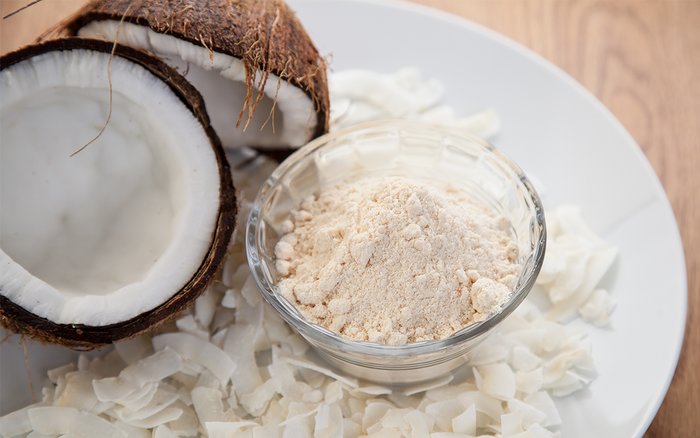
Try it in pancakes, muffins, sweet breads like zucchini bread, cakes and bars. It's also a great coating option for fish and chicken, or use it in lieu of breadcrumbs when making meatballs, patties, and meatloaf. When starting with this flour, seek out recipes that include it in the ingredient list. You can get a feel for how it behaves in cooking before you start experimenting from there.
5. Garbanzo-Bean Flour
This underappreciated flour is made by grinding up dried chickpeas into a fine powder. Garbanzo-bean flour might be obscure in the United States, but it's a common ingredient in Indian, Middle Eastern, Asian, and European cuisines. And since the yellow-tinged flour is one of the most nutrient-dense gluten-free options on the market, it looks like we are the ones missing out.
Owing to its legume origin, garbanzo flour (also called besan or gram flour) ponies up notable amounts of protein, fiber and must-have minerals such as iron.
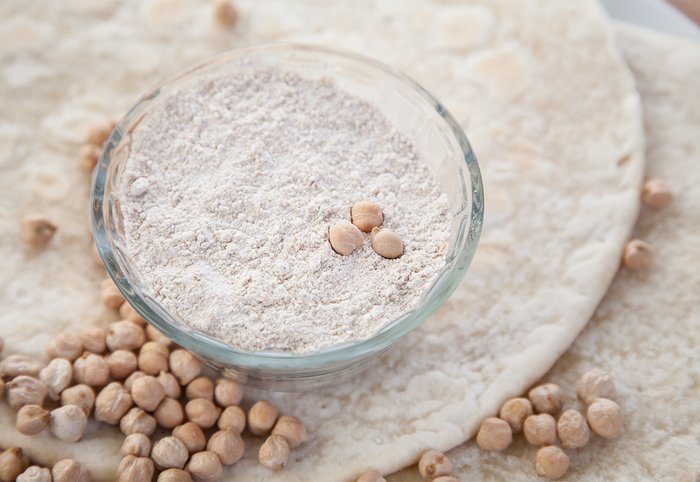
In the kitchen: With just a subtle bean flavor, try using garbanzo flour in savory applications like falafels, crackers, pizza crusts, and breads, or using it as a thickener for stews, gravies, and sauces. You can also go sweeter by sneaking it into baked goods such as muffins, cakes, and scones. It works well with strong flavors such as molasses, chocolate, and pumpkin.
Start off by replacing about 25 percent of the flour in a recipe with garbanzo flour. See how it works out. Because it's a dense flour with strong binding tendencies, garbanzo flour helps give gluten-free baked goods a sturdy yet tender texture when mixed with other gluten-free flours.

